
Victorian architecture is a series of architectural revival styles in the mid-to-late 19th century. Victorian refers to the reign of Queen Victoria (1837–1901), called the Victorian era, during which period the styles known as Victorian were used in construction. However, many elements of what is typically termed "Victorian" architecture did not become popular until later in Victoria's reign, roughly from 1850 and later. The styles often included interpretations and eclectic revivals of historic styles (see Historicism). The name represents the British and French custom of naming architectural styles for a reigning monarch. Within this naming and classification scheme, it followed Georgian architecture and later Regency architecture, and was succeeded by Edwardian architecture.

Over-the-Rhine is a neighborhood in Cincinnati, Ohio, United States. Historically, Over-the-Rhine has been a working-class neighborhood. It is among the largest, most intact urban historic districts in the United States.

The Hamilton County Memorial Building, more commonly called Memorial Hall, is located at Elm & Grant Streets, in Cincinnati, Ohio. The building is next to Cincinnati's Music Hall and across from Washington Park in the Over-the-Rhine neighborhood. It was built by the Grand Army of the Republic and Hamilton County in 1908, as a memorial to the military of the city and county. The building was built in the Beaux-Arts style. The building, including the Annie W and Elizabeth M Anderson Theater, is used for 300+ events per year.
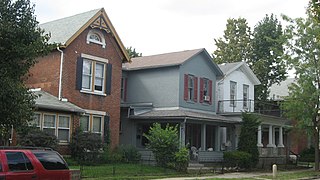
The Huffman Historic District is a historic section of the Historic Inner East neighborhood in Dayton, Ohio, United States. Formed at the end of the nineteenth century primarily by a wealthy businessman, it has long been home to people of many different occupations and numerous places on the social ladder. After seeing very few changes throughout the twentieth century, it was named a historic site in the 1980s.

The Alms and Doepke Dry Goods Company is a historic commercial building in Cincinnati, Ohio, United States. Located along Central Parkway on the edge of downtown, it is a late Victorian structure designed by Samuel Hannaford, a renowned Cincinnati architect.
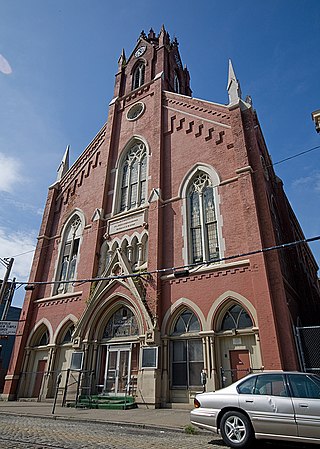
The Apostolic Bethlehem Temple Church is a historic church building in the Over-the-Rhine neighborhood of Cincinnati, Ohio, United States. A German Gothic Revival structure built in 1868, it was constructed as the home of the German Evangelical and Reformed Church, Cincinnati's oldest German Reformed Church. Founded in 1814, the church changed its name to "St. John's German Protestant Church" in 1874, although it remained in the German Reformed Church. This situation continued until 1924, when it departed for the American Unitarian Association and changed its name to "St. John's Unitarian Church." Little more than twenty years later, the congregation abandoned its old building, leaving it vacant until it was purchased by the present owners, a Pentecostal church.

The S.C. Mayer House is a historic house in the Over-the-Rhine neighborhood of Cincinnati, Ohio, United States. Constructed in the late 1880s, it has been recognized because of its mix of major architectural styles and its monolithic stone walls. Built by a leading local architect, it has been named a historic site.

The Northside United Methodist Church is a historic Methodist church in the Northside neighborhood of Cincinnati, Ohio, United States. Constructed in the 1890s for a congregation more than sixty years old, the building has been named a historic site.
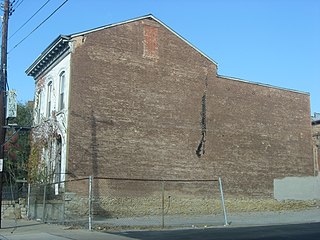
The Heinrich A. Rattermann House was a historic residence in the West End neighborhood of Cincinnati, Ohio, United States. Built in 1860, it was a brick building with a stone foundation and elements of iron and stone. It was the home of Heinrich Armin Rattermann from 1895 until his 1923 death. The most prominent German-American author in the history of the United States, Ratterman worked to solidify German-American culture; he sought to teach his compatriots their culture and produced a history of German Americans in Ohio.

Edgeton is a historic residence in the city of Hamilton, Ohio, United States. Built in the 1860s, its earliest residents were prominent businessmen in Hamilton, and it has been named a historic site.
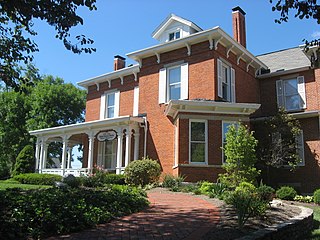
The Henry Maltby House was a historic house near the campus of Miami University in Oxford, Ohio, United States. Built in the 1850s, it was once home to a prominent minister in the community. Important partly for its architecture, it was eventually relegated to student housing before being demolished. Before its destruction, it was named a historic site.

The Montford Area Historic District is a mainly residential neighborhood in Asheville, North Carolina that is included in the National Register of Historic Places.

The Central Avenue Historic District is a small segment of the larger Grafton Hill neighborhood of Dayton, Ohio, United States. Composed of just two blocks near the border between Grafton Hill and Dayton View, the historic district comprises a cohesive collection of houses dating primarily from the turn of the 20th century, and it has been named a historic site.

The Bernard Ginsburg House is a single-family private residence located in Midtown Detroit, Michigan, within the Brush Park district. It was listed on the National Register of Historic Places in 1991.

Downtown Cincinnati is the central business district of Cincinnati, Ohio, as well the economic and symbiotic center of the Cincinnati metropolitan area. It also contains a number of urban neighborhoods in the low land area between the Ohio River and the high land areas of uptown. These neighborhoods include Over-the-Rhine, Pendleton, Queensgate, and West End.

The Sidney Walnut Avenue Historic District is a neighborhood and historic district on the western side of the city of Sidney, Ohio, United States. Located a short distance northwest of the city's downtown, the Walnut Avenue District has been Sidney's premier residential neighborhood since its creation in the late nineteenth century.
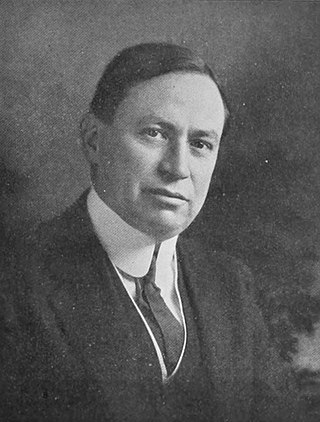
George S. Mills (1866–1939) was an English-born American architect in practice in Toledo, Ohio from 1892 until 1939. He was cofounder of a successful architectural firm which operated until 1999.

The Hollencamp House is a historic residence in the city of Xenia, Ohio, United States. Constructed as the home of a prominent immigrant businessman, it has been named a historic site.
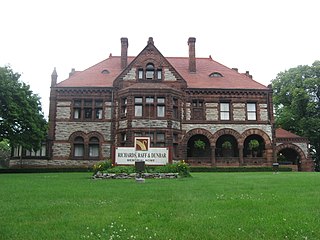
The East High Street Historic District is a cluster of mansions on the eastern side of Springfield, Ohio, United States. Located along one of Springfield's most important thoroughfares and once home to some of its most prominent residents, the cluster was named a historic district in 1974.

The John H. Clark House is a historic residence in the village of Mechanicsburg, Ohio, United States. Built during Mechanicsburg's most prosperous period, it was the home of a prominent local doctor, and it has been named a historic site because of its historic architecture.






















